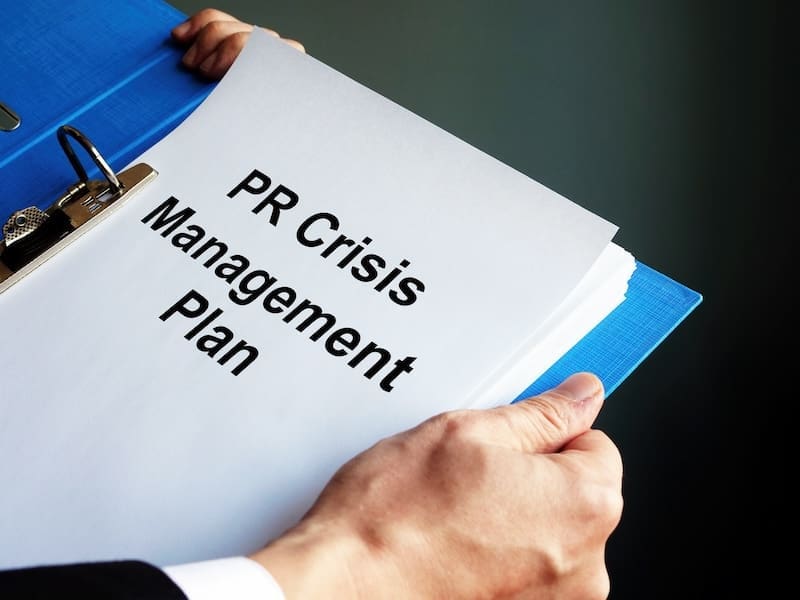
PR crisis management helps you and your organization get ahead of emerging threats while providing a roadmap for recovery after an adverse event.
In every industry, businesses will have to deal with a crisis at some point. These crises take many forms — organizational misdeeds, scandals, embarrassing arrests, or unflattering news coverage resulting from defective products, to name a few. Furthermore, as a crisis evolves, it can lead to a PR disaster.
How can businesses maintain their brand reputation and salvage consumer trust when crisis scenarios occur? In this guide, we will explore effective crisis management, including developing a robust crisis plan and creating a transparent communication strategy.
Through our parent company, NetReputation, we offer a range of ORM services, including ad management, search engine optimization, review monitoring, content removal and more. Our five-step ORM strategy ensures we cover every base to create a tailored program that’s right for you. Get in touch at 844-230-3803 to learn more.
Examples of Organizational Crises

When a PR crisis situation occurs, the crisis itself can take many forms. Examples of crises include:
- An executive scandal, such as the arrest of a business leader or financial misdeeds of key executives
- A social media crisis where unflattering or defamatory information is posted to social media channels like Facebook or LinkedIn
- A natural disaster, such as devastation from flooding, hurricanes, or tornadoes
- Industrial accidents, including warehouse fires, the death of an employee on work premises, or pollution spills
- Negative business news, such as poor earnings forecasts, unsuccessful mergers, or decreases in stock prices
- Serious injuries or deaths resulting from defective products
Negative publicity and social media backlash in the wake of a crisis have the potential to erode the trust others have in your organization’s reputation. This can potentially lead to significant financial loss. Because your reputational capital is so critical, developing a crisis management plan is an essential tool for preserving what you’ve worked so hard to achieve.
At OnlineReputation.com, we provide must-know information to individuals and businesses who want to create, grow or repair their digital reputation. Whether you’re prioritizing your personal or professional online reputation, our advice and team of experts can help. Call us today at 844-230-3803 to learn more.
What is Crisis Management?

Crisis management is the practice of preparing your company or organization for reputational threats arising from natural disasters, industrial accidents, organizational misdeeds, negative news, or other potential risks.
The goal is to minimize the impact on your company’s reputation, not only from a current crisis but also against any potential crisis that may occur.
When a negative event occurs or a potential threat poses a significant risk of financial and reputation loss, a plan can help organizations:
- Identify existing threats and potential reputational risks before they can cause negative consequences.
- Develop communication strategies to allow key stakeholders to share information with business partners and customers in a clear, concise, and transparent manner.
- Improve the efficiency of recovery efforts, helping the organization return to operations quickly after a crisis occurs.
If and when a crisis hits, any organization that has a crisis response plan in place will be able to weather the fallout. This allows the company to recover more quickly and reduce the damage to its all-important digital reputation.
Why Is Having a Good Crisis Management Plan Important?

It is no secret that negative publicity is a significant risk for business owners and organizational leaders. If a PR crisis occurs, the negative news cycle can be vicious. The media can spread inaccurate or unflattering information and negative press across public channels and media outlets.
Consumer trust is highly affected by a public relations crisis. That’s why managing that crisis with an appropriate response plan is of the utmost importance. Having a PR crisis prevention plan can help organizations:
- Define what a crisis may mean for the organization
- Assign key personnel to manage it if a crisis does occur
- Improve the safety of stakeholders and employees
- Meet regulatory standards in industries where a crisis plan is required
- Provide valuable insights into how and why incidents occur
- Serve as the foundation for rebuilding the organization when an incident or adverse event occurs
With these key factors in mind, crisis-related PR strategies should be an integral part of any business model.
More Benefits of a PR Crisis Management Strategy

Additional benefits of public relations crisis management include:
- A crisis response team is formed to respond quickly to the event and help get key messages out to the public.
- Customers, employees and stakeholders are informed of what’s happening thanks to the communication skills of the response team.
- Flexible and transparent messaging strategies are developed, allowing organizations to handle a wide range of potential crises.
- Current and potential threats are identified, giving the organization the PR crisis management tools needed to prevent future incidents from occurring.
Whether you have your own in-house crisis team or contract with a third party to provide crisis management solutions, the benefits of having a plan in place give you competitive advantages. This plan serves as a roadmap to recovery while minimizing the damage that a current crisis may present to your operations and your digital reputation.
We work with clients to help them build their online reputation and take control of their digital presence. Give us a call at 844-230-3803 to learn more.
Maintaining Brand Reputation in the Wake of a Crisis

When a crisis occurs, your brand’s reputation is at stake.
Your brand — the identifiable look, feel, and function of your organization — is widely considered to be the most valuable intangible asset you have. Protecting your reputation in the wake of a corporate scandal or an industry attack is critical.
How can you maintain your company’s reputation when a crisis happens? Some companies have chosen to play the “waiting game,” essentially acting as if the situation never happened. This can be a recipe for disaster.
The better course of action is to deploy a comprehensive crisis communication plan to address the issue immediately and with as much transparency as possible. Your public relations crisis management team can facilitate communication efforts with a public response. This gives stakeholders the information they need to understand what’s happening.
Don’t let a crisis derail your brand. What you do before, during, and after a crisis can help you maintain or even build trust between you and your customers. With ORM strategies that include crisis communications, you gain significant advantages whenever a public relations crisis threatens to undo everything you’ve worked so hard to accomplish.
It’s possible to create a robust, positive online reputation even if you’re starting from zero or rebounding from a PR crisis. Call us at 844-230-3803 for more information.
The 3-Phase Public Relations Crisis Management Plan

As your PR crisis response team develops a plan, there are three key phases of the plan that must be addressed.
- Pre-Crisis: This phase serves to identify the internal and external threats that may pose challenges to your organization. Crisis teams use sentiment analysis, negative trends analysis, industry research, and data collection to analyze potential threats, giving the organization the information it needs to make smart decisions before a crisis happens.
- Crisis Response: This phase focuses on the actions and crisis communications used during an adverse event. During a crisis, communication is essential, allowing organizations to share information with stakeholders and the general public.
- Post-Crisis: The post-crisis phase addresses the steps taken to start recovery efforts and to keep everyone informed of the recovery process.
Along with our parent company NetReputation, OnlineReputation.com provides information and services to help you protect your digital presence. Get started with a free online reputation analysis here.
Crisis Communication: A Key Component in a Response Plan

Effective crisis communications are the foundation of any crisis management plan. It cannot be overstated that media relations and positive media mentions in the wake of a crisis can help organizations recover more quickly while reducing the financial and reputational impacts of a negative situation.
Your communications manager is the point person for dealing with the media. This manager will have extensive media training, giving him or her the tools needed to speak directly and publicly. The manager often has a background as a PR specialist who is adept at all communication channels available to the organization.
From the initial press release to posts on social media platforms when a crisis presents itself, public relations professionals play an important role. In fact, the crisis communications plan is perhaps the most valuable component of the response plan.
In the modern era, crisis communications tend to take two major avenues. Each of these avenues reaches distinct audiences, allowing for efficient information sharing between the organization and its stakeholders.
1. Social Media Communication
It is no surprise that social media is one of the most valuable communication channels available to organizations facing a crisis. Posting on social media is fast and efficient, and social content is easily shared across platforms.
When an organization experiences a crisis, the social media team can post a public response on channels like X, Facebook, and LinkedIn, to name only a few of the dozens of social media channels out there.
Using social media posts allows the social media team to nip potential problems in the bud when a crisis occurs. After all, people spend countless hours on social platforms. If you present information about a crisis right away on these channels, you can eliminate the speculation and guessing that can further damage your reputation.
2. Press Releases and Media Engagement
Reputation management consists of numerous factors designed to establish, build, and protect an organization’s digital reputation. From a public relations perspective, traditional information-sharing practices like press releases, media presentations, and press conferences all have the ability to spread information during PR crises.
Media monitoring is another tactic that your PR team can handle. This gives the crisis team the ability to spot emerging PR crises before they can affect the operations and reputation of the organization.
Important Tips for Responding to a PR Crisis

When a crisis happens, organizations without a plan in place often find themselves struggling to recover from the fallout. With a robust crisis plan ready to go, your organization has the tools and the strategies needed to respond quickly.
Here are some communications tips for your marketing team that can help you thrive even in the wake of a natural or industrial disaster:
- Accept responsibility for the incident if the PR crisis was the result of a scandal, corporate misdeed, or product defect. Do not deflect blame; own up to your mistakes and provide your customers with the information they need to know right away.
- Never respond negatively, regardless of the type or severity of the crisis. Negative responses tend to backfire, potentially damaging your reputation even further. Instead, focus on what information you need to share and when to let everyone know of your plan as the crisis unfolds. Positive responses should also be directed toward any negative review you receive on Google or third-party review platforms.
- Offer trauma counseling as part of your PR push. Customers and stakeholders negatively affected by a crisis can benefit from counseling. By offering help, you demonstrate that you are aware of the challenges faced by a crisis and are providing essential services to help affected parties recover.
The worst thing you can do is fail to act quickly. Having a quick reaction to a budding PR crisis is a must. Start communication right away and spread accurate information from the get-go to derail any harmful content that’s making its rounds.
Contact Us Today
Every company faces challenging times at one point or another. And since there’s a high chance that you’ll be dealing with your own PR crisis eventually, the best way to handle it in the future is to prepare for it now.
Instead of trying to figure out what to do in real time while a crisis is occurring, create a crisis plan long before you need one. Figure out what your first step will be in the event of a crisis, decide how your team will stay updated as the situation unfolds, and develop strategies that keep you ahead of the story so you can influence public perception.
Want to learn more about crisis management plans and the need for an effective PR crisis strategy? Call OnlineReputation today at 844-230-3803 to speak with ORM professionals and expert crisis response planners.
You might also like
What Is the Impact of Branding in Digital Marketing?
PR crisis management helps you and your organization get ahead of emerging threats while providing a roadmap for recovery after …
